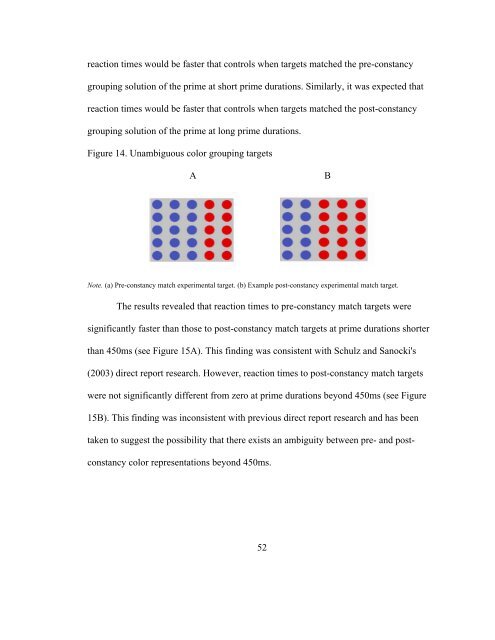The Use of Iambic Pentameter in the
The Use of Iambic Pentameter in the
The Use of Iambic Pentameter in the
Create successful ePaper yourself
Turn your PDF publications into a flip-book with our unique Google optimized e-Paper software.
eaction times would be faster that controls when targets matched <strong>the</strong> pre-constancy<br />
group<strong>in</strong>g solution <strong>of</strong> <strong>the</strong> prime at short prime durations. Similarly, it was expected that<br />
reaction times would be faster that controls when targets matched <strong>the</strong> post-constancy<br />
group<strong>in</strong>g solution <strong>of</strong> <strong>the</strong> prime at long prime durations.<br />
Figure 14. Unambiguous color group<strong>in</strong>g targets<br />
A<br />
Note. (a) Pre-constancy match experimental target. (b) Example post-constancy experimental match target.<br />
<strong>The</strong> results revealed that reaction times to pre-constancy match targets were<br />
significantly faster than those to post-constancy match targets at prime durations shorter<br />
than 450ms (see Figure 15A). This f<strong>in</strong>d<strong>in</strong>g was consistent with Schulz and Sanocki's<br />
(2003) direct report research. However, reaction times to post-constancy match targets<br />
were not significantly different from zero at prime durations beyond 450ms (see Figure<br />
15B). This f<strong>in</strong>d<strong>in</strong>g was <strong>in</strong>consistent with previous direct report research and has been<br />
taken to suggest <strong>the</strong> possibility that <strong>the</strong>re exists an ambiguity between pre- and post-<br />
constancy color representations beyond 450ms.<br />
52<br />
B

















